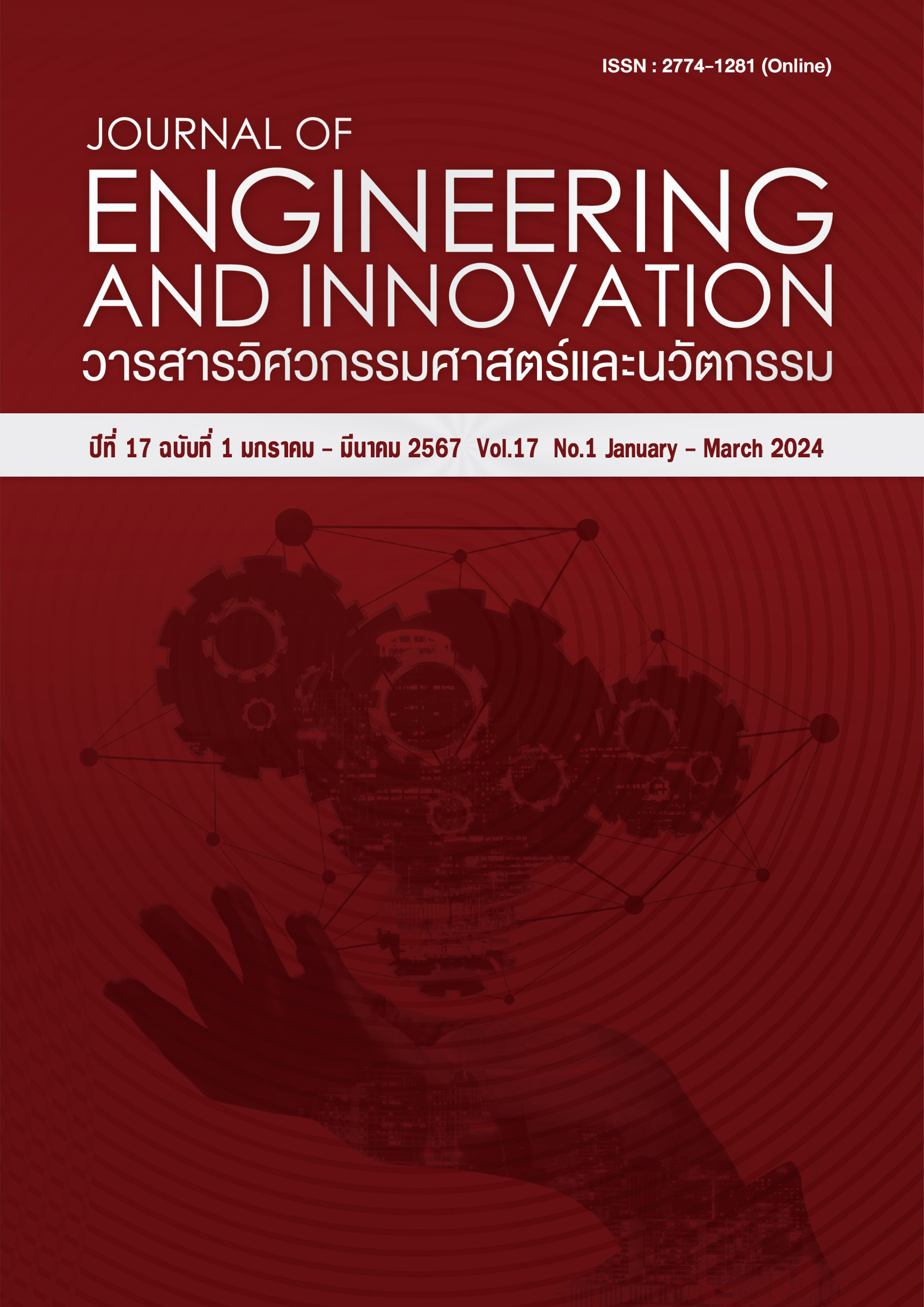Effect of Additional Contents and Particle Sizes of Rice Husk Ash on Physical and Mechanical Properties of Recycled-Polypropylene Composites
Main Article Content
Abstract
This research is a primary study of polypropylene composites mixed with rice husk ash. Polypropylene in this study was recycled from drinking water bottles, hot food packaging bags, bags of saline solution, and storage baskets. Two sizes of rich husk ash were used in this study, 17 and 29 µm, mixed with recycled polypropylene at 1:7 PHR proportion. The compound preparation process was made possible a with Twin Screw Extruder and the composite and sample works were created by a hot-pressing process. Results of this study indicated that the types of recycled-polypropylene affected the mechanical and physical properties significantly. The size of rice husk ash affected the hardness value, impact resistance value, and melting index. Increasing the proportion of rice husk ash from 1 to 7 PHR significantly affected the tensile strength, hardness value, impact resistance value, and melting index. The possible trend of this study revealed that a higher proportion of rice husk ash addition resulted in higher hardness and Young’s modulus values. However, it reduced the impact resistance, the stretch percentage, and melting index values. In terms of the different sizes of rice husk ash addition, it was found that the impact resistance value of composites, which had rice husk ash of 29 µm addition was higher than rich husk ash of 17 µm. In terms of the melting index, the value of composites which had rice husk ash of 17 µm addition was higher than composites which had rice husk ash of 29 µm addition. Consequently, the composite from this study could be used to form sample products.
Article Details
References
สำนักงานเลขาธิการสภาผู้แทนราษฎร. เศรษฐกิจหมุนเวียน (Circular Economy). [ออนไลน์], แหล่งที่มา: https://library2.parliament.go.th/ ebook/content-issue/2562/hi2562-010.pdf [เข้าถึงเมื่อ 11 มีนาคม 2564]
อนุชิต คงฤทธิ์, กนกวรรณ แช่มพุดซา, รัชนก แป้นโพธิ์กลาง, พงษ์ศักดิ์ รุนกระโทก และจิตติวัฒน์ นิธิกาญจนธาร. อิทธิพลของสารคู่ควบต่อสมบัติทางกลของพอลิเมอร์ผสมระหว่างพอลิโพรพิลีนรีไซเคิลและพอลิเอทิลีนความหนาแน่นสูงรีไซเคิล. วารสารวิศวกรรมศาสตร์มหาวิทยาลัยศรีนครินทรวิโรฒ. 2559. 11(2); หน้า 57-66.
อนุชิต คงฤทธิ์ และจิตติวัฒน์ นิธิกาญจนธาร. ผลกระทบของสารช่วยผสานที่มีต่อสมบัติทางกลและสมบัติทางกายภาพของคอมโพสิตพอลิโพรพิลีนผสมกากกาแฟ. วารสารวิชาการ วิศวกรรมศาสตร์ ม.อบ. 2561; 11(1) . หน้า 18-28.
จิตติวัฒน์ นิธิกาญจนธาร และอนุชิต คงฤทธิ์. ผลกระทบของสารเชื่อมโยงและระยะเวลาการอบไอน้ำในกระบวนการเชื่อม โยงสายโซ่ที่มีต่อสมบัติทางกลและสมบัติทางกายภาพของพอลิออกซีเมทิลลีนรีไซเคิล. วารสารวิชาการ วิศวกรรมศาสตร์ ม.อบ. 2562; 12(2). หน้า 49-62.
กรีนพีซ. อะไรคือ "พลาสติกใช้ครั้งเดียวทิ้ง" [ออนไลน์], แหล่งที่มา: https://www.green peace.org /thailand/explore/resist/plastic1/single-use-plastic/ [เข้าถึงเมื่อ 13 มีนาคม 2564]
เกียรติสุดา สมนา, ประมวล พันชนะ และรัฐพล สมนา. กำลังอัดและโครงสร้างจุลภาคของจีโอพอลิเมอร์ที่ใช้เถ้าก่านหินและซิลิก้าที่สกัดจากเถ้าแกลบ. วารสารวิชาการพระจอมเกล้าพระนครเหนือ. 2564; 13(1). หน้า 25-35.
Alfaro E.F., Dias D.B. and Silva L.G.A. The study of ionizing radiation effects on polypropylene and rice husk ash composite, Radiation Physics and Chemistry. 2013; 84: 163–165.
Hanafi Ismail, Nizam J.M. and Abdul Khalil H.P.S. The effect of a compatibilizer on the mechanical properties and mass swell of white rice husk ash filled natural rubber/linear low density polyethylene blends, Polymer Testing. 2001; 20: 125–133.
Nawadon P. and Jakkid S. Static and Dynamic Mechanical Properties of Poly (vinyl chloride) andWaste Rice Husk Ash Composites Compatibilized with y-aminopropyltrimethoxy silane, Silicon. 2018; 10: 287–292.
SIRIWARDENA S., ISMAIL H. and ISHIAKU U. S. A Comparison of the Mechanical Properties and Water Absorption Behavior of White Rice Husk Ash and Silica Filled Polypropylene Composites, journal of Reinforced Plastics and Composites. 2003; 22(18): 1645-1666.
Rissanen, J., Ohenoja, K., Kinnunen, P., Romagnoli, M., & Illikainen, M. Milling of peat-wood fly ash: Effect on water demand of mortar and rheology of cement paste. Construction and Building Materials, 180, 143-153.
Djobo, J. N. Y., Elimbi, A., Tchakouté, H. K., & Kumar, S. (2016). Mechanical activation of volcanic ash for geopolymer synthesis: effect on reaction kinetics, gel characteristics, physical and mechanical properties. RSC advances. 2018; 6(45): 39106-39117.
Mucsi, G., Molnar, Z., & Kumar, S. Geopolymerisation of mechanically activated lignite and brown coal fly ash. Acta Physica Polonica A. 2014; 126(4): 994-998.
ASTM D1238-13, Standard Test Method for Melt Flow Rates of Thermoplastics by Extrusion Plastometer, ASTM International, West Conshohocken, PA, 2013, www.astm.org
ASTM D638-14, Standard Test Method for Tensile Properties of Plastics, ASTM International, West Conshohocken, PA, 2014, www.astm.org
ASTM D2240-15e1, Standard Test Method for Rubber Property—Durometer Hardness, ASTM International, West Conshohocken, PA, 2015, www.astm.org
ASTM D256-10(2018), Standard Test Methods for Determining the Izod Pendulum Impact Resistance of Plastics, ASTM International, West Conshohocken, PA, 2018, www.astm.org
Simone M. L. Rosa., Sônia M. B. Nachtigall and Carlos A. Ferreira. Thermal and Dynamic-Mechanical Characterization of Rice-Husk Filled Polypropylene Composites, Macromolecular Research, 2009.;17(1) : 8-13.
Sevdalina T., Svetlana G and Lyubomir V. Obtaining Some Polymer Composites Filled with Rice Husks Ash-A Review, International Journal of Chemistry. 2012; 4(4): 62-89.
Vlachopoulos J. and Strutt D. Overview Polymer processing, Materials Science and Technology. 2003; 19: 1161-1169.
Deeptangshu S. C., Margaret C. J and Ferenc C. Recycling rice hull ash: A filler material for polymeric composites, Advances in Polymer Technology. 2004; 23(2): 147–155.
Chaudhary D.S., Jollands M.C. and Cser F. Understanding rice hull ash as fillers in polymers: A review, Silicon Chemistry 1. 2002; 281–289.

